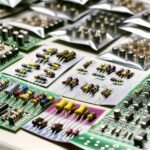Imagine a world where you have the power to create your own solar-powered gadgets, tailored to your specific needs and preferences. Coincidentally, DIY electronics kits for building such devices have become increasingly popular, offering a range of possibilities for the tech-savvy individual.
But why should you consider diving into this exciting world of solar-powered DIY projects? Well, let's just say that the advantages go far beyond simply saving energy and reducing your carbon footprint.
Intrigued? Then keep on reading to discover the endless potential that awaits you.
Key Takeaways
- DIY electronics kits for building solar-powered gadgets provide a hands-on learning experience for users of all skill levels.
- These kits offer the ability to customize and modify devices according to specific needs and preferences.
- They are cost-effective compared to purchasing ready-made gadgets, making solar-powered technology more accessible.
- Building solar chargers using these kits involves a step-by-step process of selecting a suitable location, mounting the solar panel, connecting the charge controller and battery, testing the installation, and troubleshooting if necessary.
Benefits of DIY Electronics Kits
One of the key advantages of DIY electronics kits is that they provide a hands-on learning experience for users of all skill levels. Whether you're a beginner or an experienced electronics enthusiast, these kits offer a practical way to learn and understand the principles of electronics. By assembling the components and following the step-by-step instructions, you get to see firsthand how the various parts interact and function together to create a working device.
Another advantage of DIY electronics kits is the freedom and flexibility they provide. Unlike pre-built gadgets, these kits allow you to customize and modify the device according to your specific needs and preferences. This empowers you to create unique and personalized gadgets that cater to your individual requirements.
Furthermore, DIY electronics kits are cost-effective compared to purchasing ready-made gadgets. By building your own device, you save on the costs associated with labor and manufacturing. Additionally, you gain the knowledge and skills necessary to troubleshoot and repair your gadgets, reducing the need for expensive professional assistance.
However, it's important to acknowledge that DIY electronics kits also have some disadvantages. Firstly, they require time and effort to assemble, especially for beginners who may be unfamiliar with the components and the assembly process. Additionally, there's a risk of damaging the components during assembly, which could lead to additional costs for replacements.
Essential Components for Solar-Powered Gadgets
To explore the essential components for solar-powered gadgets, let's now focus on the key elements required to harness solar energy efficiently. Solar energy has numerous advantages, such as being a clean and renewable source of power. However, to harness this energy effectively, there are certain components that you need to consider.
One of the essential components for solar-powered gadgets is the solar panel. This is responsible for converting sunlight into usable electricity. It is crucial to choose a solar panel that is efficient and durable, as it will directly impact the performance of your gadget.
Another important component is the charge controller. This device regulates the amount of charge that flows from the solar panel to the battery. It prevents overcharging and ensures that the battery receives the optimal amount of energy.
The battery is also a crucial component, as it stores the energy generated by the solar panel. It is important to choose a battery with the right capacity and voltage to meet the power requirements of your gadget.
To emphasize the importance of these components, let's take a look at the table below:
| Component | Function |
|---|---|
| Solar Panel | Converts sunlight into electricity |
| Charge Controller | Regulates charge flow |
| Battery | Stores generated energy |
Step-by-Step Guide to Building Solar Chargers
Start by gathering all the necessary components and tools for building your own solar chargers. Here's a step-by-step guide to help you along the way:
- Solar Panel Installation
- Begin by selecting a suitable location for your solar panel installation. Ensure that it receives ample sunlight throughout the day.
- Mount the solar panel securely, either on a roof or a sturdy frame, using the appropriate fasteners.
- Connect the solar panel to a charge controller to regulate the voltage and current flowing from the panel to the battery.
- Connect the charge controller to the battery using the provided cables, ensuring the correct polarity.
- Test the solar panel installation by measuring the voltage output using a multimeter.
- Troubleshooting Solar Chargers
- If your solar charger isn't working properly, check the connections between the solar panel, charge controller, and battery.
- Inspect the solar panel for any damage or obstructions that may be blocking sunlight.
- Verify that the charge controller is functioning correctly by checking the LED indicators or using a multimeter.
- Test the battery voltage to ensure it's within the recommended range.
- If necessary, consult the manufacturer's troubleshooting guide or seek assistance from a professional.
- Additional Tips
- Consider using a solar charge controller with built-in USB ports for convenient charging of your devices.
- Utilize a power inverter to convert the DC power from the battery to AC power for powering household appliances.
- Regularly monitor the performance of your solar charger and make any necessary adjustments to maximize efficiency.
Exploring Solar-Powered Lighting Solutions
When exploring solar-powered lighting solutions, it's essential to consider the efficiency and durability of the lighting fixtures. Solar energy in agriculture and solar-powered transportation are two areas where solar-powered lighting solutions can be highly beneficial.
In agriculture, solar-powered lighting can be used to illuminate greenhouses and agricultural fields, providing the necessary light for plant growth. This eliminates the need for traditional electricity sources and reduces energy costs. Solar-powered lighting fixtures designed for agricultural applications are built to withstand harsh weather conditions and are highly durable.
In the realm of solar-powered transportation, solar lighting solutions play a vital role in ensuring safety and visibility. Solar-powered streetlights can be installed along roads and highways, providing illumination without relying on grid electricity. Not only does this reduce energy consumption and carbon emissions, but it also improves road safety for drivers and pedestrians. Solar-powered lighting fixtures for transportation applications are designed to be highly efficient, using advanced LED technology to provide bright and reliable lighting.
When choosing solar-powered lighting solutions, it's crucial to consider the specific requirements of your application. Look for fixtures that offer high energy efficiency, long lifespan, and durability. Additionally, consider the ease of installation and maintenance.
Building Advanced Solar-Powered Gadgets
Efficient and durable solar-powered lighting solutions pave the way for the next step: building advanced solar-powered gadgets. With the advancements in solar technology, it's now possible to create innovative solar-powered devices that go beyond just lighting. Here are three exciting possibilities:
- Advanced Solar Powered Vehicles: Imagine a car that runs solely on solar power, eliminating the need for fossil fuels and reducing carbon emissions. These vehicles utilize high-capacity solar panels and advanced battery systems to store energy efficiently. They aren't only environmentally friendly but also offer the freedom to travel without relying on traditional energy sources.
- Solar-Powered Wearable Devices: Harnessing the power of the sun, these innovative gadgets can be worn on your body and provide various functions. From solar-powered smartwatches that track your fitness and display notifications to solar-powered GPS trackers for outdoor enthusiasts, these devices offer the convenience of being independent from charging cables.
- Solar-Powered Home Automation Systems: Take control of your home's energy usage with solar-powered home automation systems. These intelligent devices use solar energy to power and control various aspects of your home, such as lighting, temperature, and security. With the freedom to manage your home's energy consumption, you can save money and reduce your carbon footprint.






